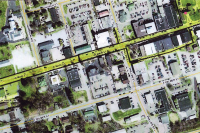County landfills grapple with fluorescent bulb conundrum
 A compact fluorescent light bulb uses about 75 percent less energy than the old-fashioned kind and lasts up to 10 times longer. They may cost more upfront, but a net savings of $25 during the life of each bulb has spurred American households to make the switch en masse to the energy-saving bulbs in recent years.
A compact fluorescent light bulb uses about 75 percent less energy than the old-fashioned kind and lasts up to 10 times longer. They may cost more upfront, but a net savings of $25 during the life of each bulb has spurred American households to make the switch en masse to the energy-saving bulbs in recent years.
But there’s a little-known fact behind the bulb that’s otherwise so environmentally friendly on the surface. Compact fluorescent light bulbs contain mercury that can end up in the air or water if not disposed of properly.
Yet, in many North Carolina communities, the bulbs end up in the trash and eventually the landfill rather than special disposal programs.
“It’s a dirty little secret that we’re not managing them properly,” Macon Solid Waste Director Chris Stahl said.
Soon, however, Macon County will be one of the few in North Carolina to set up a system for collecting and properly disposing of the compact fluorescent bulbs.
It’s a long time coming, Stahl said, expressing his frustration with dealing with them during the years without a proper system in place.
Related Items
“I have hated bulbs for 11 years,” Stahl said.
Macon County will collect bulbs from residents for free. They will then be shipped to a facility in South Carolina for processing. Commercial entities will be charged 75 cents per fluorescent bulb.
The program should be in place by January 2013, contingent on receiving the required state permits and a grant that will hopefully help cover the special disposal costs.
Without a disposal program in place, Stahl previously referred business owners and residents who brought him bulbs to disposal centers as far away as Asheville or Johnson City, Tenn. Some large retail stores such as Lowe’s also accept fluorescent bulbs. But Stahl was doubtful many residents made the extra trip.
“If you bring me 20 bulbs, I would refer you to places which are authorized to take them,” Stahl said. “But what you might do instead is take heavy duty trash bags, break them into little bits and bring them back to my facility. And I don’t look into every bag.”
In North Carolina, only 20 counties and a few cities are set up to collect bulbs. Many large businesses have contracts with companies to collect their bulbs, and some residents use mail-in programs, in which a prepaid box is shipped full of the fluorescent lights to a processing facility.
Mercury in the trash
But as it stands, many residents just throw them in the trash, which is not explicitly illegal. While it is illegal for commercial entities to throw fluorescent bulbs away, residential light bulbs containing mercury are given a free pass to the trash.
The N.C. Department of Environment and Natural Resources only goes as far as strongly encouraging residents handle the bulbs properly.
Scott Mouw, the state’s recycling director, said the best way to keep the fluorescent bulbs and their mercury out of the landfill would be to have local towns and counties operating, and promoting their local programs.
Because even though residents can toss the fluorescent bulbs in the trash, mounting levels of mercury can be troublesome for landfills. A typical compact fluorescent bulb contains about three milligrams of mercury — the equivalent of the tip of a ballpoint pen. Once thrown in the trash, the mercury can eventually find its way to water and contaminate fish populations.
Eating contaminated fish is one of the most common ways humans ingest harmful mercury.
And although three milligrams of mercury per bulb is seemingly a small amount, Mouw predicts it will become more of a problem given the sheer number that are out there.
“There will be a lot more of them over time,” Mouw said. “Incandescent bulbs are starting to lose the market share.”
In the region, Buncombe, Haywood, Swain, and soon Macon counties have disposal programs. Jackson County does not have a residential program.
In Jackson County, Public Works Director Chad Parker, who also oversees solid waste, said he refers residents to Lowe’s. Yet, for a county that is roughly 500 square miles, only using retail stores such as the hardware giant can limit accessibility, versus accepting the bulbs at all eight of the county’s trash sites.
“For residents, we don’t have a program in house,” Parker said. “But it’s something we’ll be looking at.”
Counties, like commercial entities, are supposed to dispose of their fluorescent bulbs properly. Parker said he hopes the county could piggy-back off the program they use for the county’s own bulbs while implementing one for residential disposal.
However, he cited the law as being on the county’s side for the time being when it comes to handling residential fluorescent bulbs.
“The only thing I can say is that residential bulbs can go into garbage,” Parker said. “Commercial waste has to be dealt with separately, but the state will allow residential bulbs to go into the waste stream.”
A growing program
Meanwhile, Haywood County has been ahead of the curve. It’s been following best-practices for compact florescent bulbs for about five years. It is free for residents to drop off their fluorescent bulbs.
And county Solid Waste Director Stephen King reports each year, more residents are setting aside their burned out bulbs and bringing them to county trash sites for processing.
In 2009 when the county started taking bulbs in Haywood County, its facilities collected about 5,000 feet of fluorescent light bulbs. In 2011, the county collected about 37,000 feet. Already, in the first four months of this fiscal year, 15,000 feet of bulbs have been collected.
He said a majority of those are not the long, four- or eight-foot tubes, but rather the small, compact fluorescent bulbs.
“As people become more and more aware, we have more and more participation,” King said. “It’s actually pretty easy to do, which is great because it’s not going into landfill.”
He said the primary reason for collecting the bulbs was to keep mercury from leeching out of the landfill and into the water. But, King is so leery of the bulbs and the mercury in them he doesn’t even allow them in his home.
When a fluorescent bulb breaks it releases a small amount of mercury vapor. The EPA recommends if one breaks inside, people and pets should evacuate the room for five to 10 minutes and any air circulation devices should be shut off.
“I have a hard time with mercury-containing devices where kids can break it and breathe it in,” said King, who is also a father. “When you start looking at the whole picture, they’re not as green as we thought they were.”













